Related Research Articles
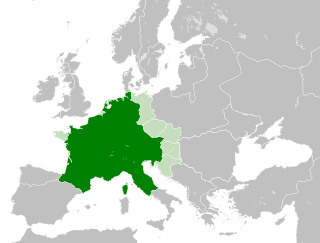
The Carolingian Empire (800–887) was a Frankish-dominated empire in Western and Central Europe during the Early Middle Ages. It was ruled by the Carolingian dynasty, which had ruled as kings of the Franks since 751 and as kings of the Lombards in Italy from 774. In 800, the Frankish king Charlemagne was crowned emperor in Rome by Pope Leo III in an effort to transfer the Roman Empire from the Byzantine Empire to Western Europe. The Carolingian Empire is sometimes considered the first phase in the history of the Holy Roman Empire.

Carloman I, German Karlmann, Karlomann, was king of the Franks from 768 until his death in 771. He was the second surviving son of Pepin the Short and Bertrada of Laon and was a younger brother of Charlemagne. His death allowed Charlemagne to take all of Francia.

Carloman II was the King of West Francia from 879 until his death. A member of the Carolingian dynasty, he and his elder brother, Louis III, divided the kingdom between themselves and ruled jointly until the latter's death in 882. Thereafter Carloman ruled alone until his own death. He was the second son of King Louis the Stammerer and Queen Ansgarde.

Louis III was King of West Francia from 879 until his death in 882. Despite questions of his legitimacy and challenges against his ascendance to the monarchy, Louis would prove to be an effective leader during his reign, notable for the defeat of Viking invaders at the Battle of Saucourt-en-Vimeu in August 881 that would later be immortalized in the poem Ludwigslied. He also led a less successful military campaign against Boso of Provence with help from Charles the Fat.
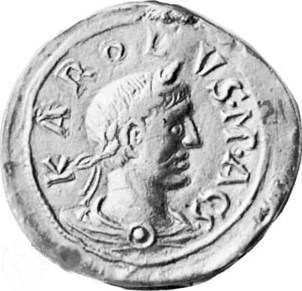
Charles the Fat was the emperor of the Carolingian Empire from 881 to 887. A member of the Carolingian dynasty, Charles was the youngest son of Louis the German and Hemma, and a great-grandson of Charlemagne. He was the last Carolingian emperor of legitimate birth and the last to rule a united kingdom of the Franks.

Louis V, also known as Louis the Do-Nothing, was a king of West Francia from 979 to his early death in 987. During his reign, the nobility essentially ruled the country. Dying childless, Louis V was the last Carolingian monarch in West Francia.
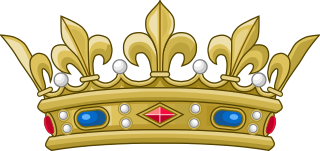
Fils de France was the style and rank held by the sons of the kings and dauphins of France. A daughter was known as a fille de France.
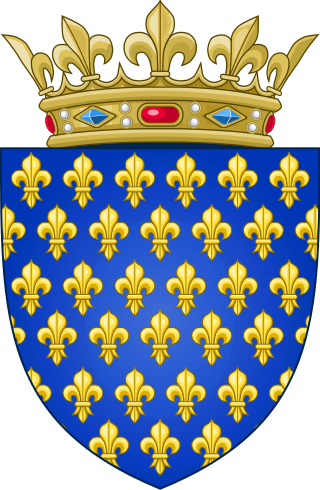
The House of Capet ruled the Kingdom of France from 987 to 1328. It was the most senior line of the Capetian dynasty – itself a derivative dynasty from the Robertians and the Karlings.

Boso was a Frankish nobleman of the Bosonid family who was related to the Carolingian dynasty and who rose to become King of Lower Burgundy and Provence.
The Elder House of Welf was a Frankish noble dynasty of European rulers documented since the 9th century. Closely related to the Carolingian dynasty, it consisted of a Burgundian and a Swabian group. It has not been definitively clarified, however, whether the two groups formed one dynasty or whether they shared the same name by coincidence only. While the Elder House became extinct in the male line with the death of Duke Welf of Carinthia in 1055, his sister Kunigunde married into the Italian House of Este and became the ancestor of the (Younger) House of Welf.

Middle Francia was a short-lived Frankish kingdom which was created in 843 by the Treaty of Verdun after an intermittent civil war between the grandsons of Charlemagne resulted in division of the united empire. Middle Francia was allocated to emperor Lothair I, the eldest son and successor of emperor Louis the Pious. His realm contained the imperial cities of Aachen and Pavia, but lacked any geographic or cultural cohesion, which prevented it from surviving and forming a nucleus of a larger state, as was the case with West Francia and East Francia.
Hugh or Hugo was an illegitimate son of Lothair II, king of Lotharingia, by his mistress Waldrada. His father made him Duke of Alsace in 867.
The Bosonids were a dynasty of Carolingian era dukes, counts, bishops and knights descended from Boso the Elder. Eventually they married into the Carolingian dynasty and produced kings and an emperor of the Frankish Empire.

Emma of France was a Frankish queen. The daughter of Robert I of France, she was a descendant of the powerful aristocratic Robertian family; her younger half-brother was Hugh the Great, the duke of the Franks and count of Paris.
Adélaïde of Paris (Aélis) was a Frankish queen. She was the second wife of Louis the Stammerer, King of West Francia and mother of Charles the Simple.
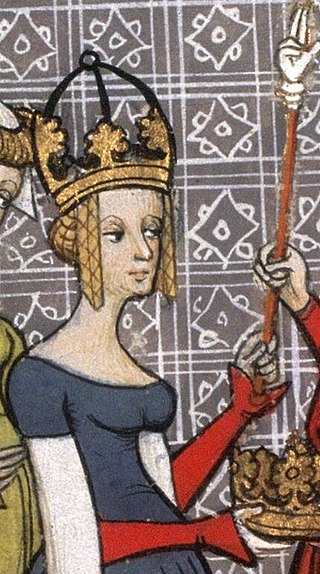
Richilde of Provence was the second wife of the Frankish emperor Charles the Bald. By her marriage, she became queen and later empress. She ruled as regent in 877.

After the death of the last Habsburg monarch of Spain in 1700, the childless Charles II, the Spanish throne was up for grabs between various dynasties of Europe despite Charles having left a will naming his heir. In this will, Charles left Philip, Duke of Anjou, grandson of Louis XIV of France, the possessions of the Spanish Crown.

Louis the Stammerer was the king of Aquitaine and later the king of West Francia. He was the eldest son of Emperor Charles the Bald and Ermentrude of Orléans. Louis the Stammerer was physically weak and outlived his father by a year and a half.
Succession to the French throne covers the mechanism by which the French crown passed from the establishment of the Frankish Kingdom in 486 to the fall of the Second French Empire in 1870.

Louis IV, called d'Outremer or Transmarinus, reigned as King of West Francia from 936 to 954. A member of the Carolingian dynasty, he was the only son of king Charles the Simple and his second wife Eadgifu of Wessex, daughter of King Edward the Elder of Wessex. His reign is mostly known thanks to the Annals of Flodoard and the later Historiae of Richerus.
References
- 1 2 Schneider, Jens (2003). "Les Northmanni en Francie occidentale au IXe siècle : le chant de Louis". Annales de Normandie (in French). 53 (4): 291–315. doi:10.3406/annor.2003.1453.
- ↑ Pinoteau, Hervé (1996). "Encore Charles II le Chauve et sa symbolique". Emblemata: Revista aragonesa de emblemática (2): 9–34. ISSN 1137-1056.
- 1 2 3 McDougall, Sara (2017). Royal Bastards: The Birth of Illegitimacy, 800-1230. Oxford University Press. ISBN 978-0-19-878582-8.
- ↑ MacLean, Simon (2017). Ottonian Queenship. Oxford University Press. ISBN 978-0-19-880010-1.
- ↑ Garver, Valerie L. (2012-05-08). Women and Aristocratic Culture in the Carolingian World. Cornell University Press. ISBN 978-0-8014-6017-3.
- ↑ Mckitterick, Rosamond (2018-10-08). The Frankish Kingdoms Under the Carolingians 751-987. Routledge. ISBN 978-1-317-87247-4.
- Martina Hartmann: Die Königin im frühen Mittelalter. Kohlhammer, Stuttgart 2009, ISBN 978-3-17-0184-73-2